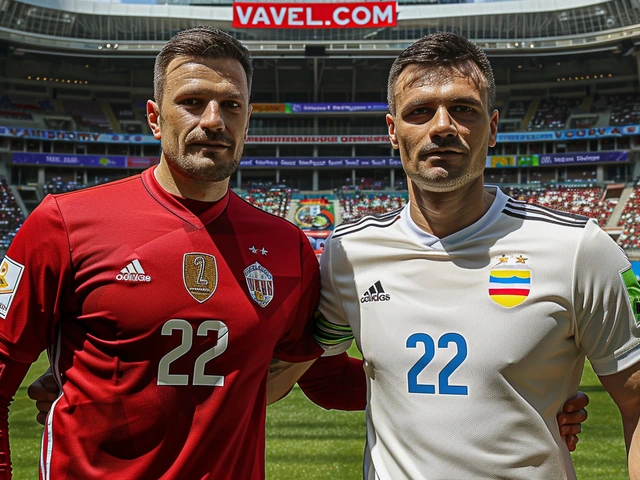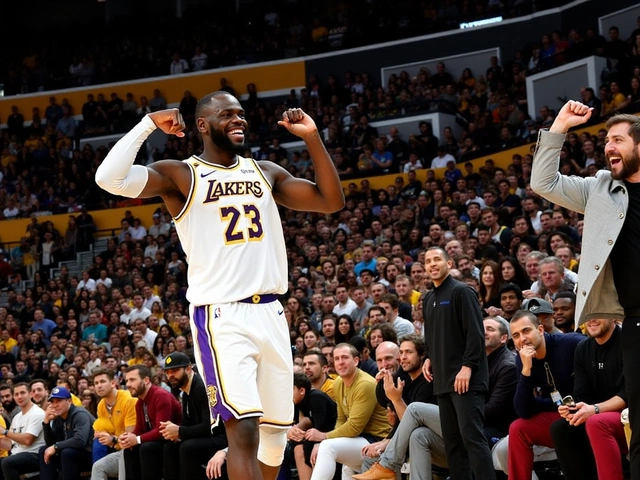Bayern Munich 6-0 RB Leipzig: Kane hat-trick launches ruthless Bundesliga opener

Bayern make a statement on opening night
Bayern Munich didn’t just start their title defense. They tore right into it. On a crisp Friday night at the Allianz Arena, the champions routed RB Leipzig 6-0 to open the 2025-26 Bundesliga season, a scoreline powered by Harry Kane’s ruthless second-half burst and Michael Olise’s slick first-half double. Luis Díaz added the other in a one-sided match that felt settled long before the hour.
The tone was set early: Bayern owned the ball, pinned Leipzig back, and created angles at will. Olise broke the deadlock in the 27th minute, drifting inside from the right and finishing with the kind of calm that makes a sold-out stadium sound like an echo chamber. Five minutes later, Díaz arrived from the left to make it 2-0, the move built on quick combinations through Joshua Kimmich and Serge Gnabry that pulled Leipzig’s back line apart.
Just before the break, Olise struck again in the 42nd minute. By then, Bayern’s patterns were flowing—full-backs stepping in, wingers swapping channels, Kane connecting everything between the lines. Leipzig looked stuck between pressing and retreating, and that hesitation was punished.
The second half belonged to Kane. He needed 13 minutes to get going and then didn’t stop: goals in the 64th, 74th, and 77th minutes completed a crisp Kane hat-trick. The finishes were a mix of predatory movement and clean technique—one-touch in the area, a composed strike after a delayed run, and a near-post dart that left Peter Gulácsi stranded. When Bayern’s No. 9 finds that rhythm, defenders start guessing and usually guess wrong.
Manager Vincent Kompany rolled out a familiar 4-2-3-1 with Manuel Neuer behind a back four of Josip Stanisic, Jonathan Tah, Dayot Upamecano, and Konrad Laimer. Kimmich and Leon Goretzka anchored midfield, with Olise and Díaz flanking Gnabry behind Kane. It was aggressive, high-tempo football—clear triggers to press, quick switches to isolate full-backs, and steady recycling through Kimmich to reset attacks when Leipzig briefly escaped.
There were eyebrow-raising moments on the bench, too. Kompany moved fast with his changes: Sacha Boey replaced a booked Laimer as early as the 23rd minute to avoid a second caution at right-back, and Aleksandar Pavlović came in for Goretzka at halftime to keep Bayern’s passing crisp. Lennart Karl replaced Gnabry late in the first half after the winger took a knock, and Minjae Kim entered in the third minute for the yellow-carded Tah—an unusually early defensive change that hinted at either a fitness caution or tactical concern. Jonah Kusi-Asare got minutes late on for Kane at 86’ amid a standing ovation.
Leipzig tried to hold their 4-3-3 shape: Gulácsi in goal, a back line of Ridle Baku, Willi Orbán, Castello Lukeba, and David Raum; midfielders Xaver Schlager, Nicolas Seiwald, and Yan Diomande; with Johan Bakayoko, Lois Openda, and Xavi Simons up front. The plan was to spring Openda early, use Simons between the lines, and push Raum to overlap. But with Bayern dominating the ball—67% possession by full time—those outlets rarely connected. When Leipzig managed to play through, they met Dayot Upamecano stepping up aggressively and Neuer sweeping behind.
The numbers back up what everyone saw. Bayern out-shot Leipzig 18-5 and hit the target 10 times to Leipzig’s one. Corners went 7-2. It wasn’t just volume—it was field position. Bayern recovered loose balls around Leipzig’s box and turned them into chances; second phases from corners kept Leipzig pinned. Orbán took a booking trying to slow Kane, and Leipzig’s midfield collected fouls that never quite broke Bayern’s rhythm.
Individually, the standouts were obvious. Kane’s movement dragged center-backs into bad decisions. Olise, who looked completely at home on the right, kept slipping into pockets that Leipzig didn’t track. Díaz offered constant width on the left, and when he cut inside, Raum suddenly had two problems to solve—track the runner or block the overlap. Kimmich’s range dictated tempo and switched play whenever Leipzig overloaded a side.
There was steel in the details. Bayern’s back line was reshuffled early, but the structure didn’t bend. Analysts rated Minjae Kim at 7.23, a tidy return for a defender thrust into action with 87 minutes to go. Stanisic rarely lost a duel, and Upamecano stepped into midfield to intercept before Leipzig could turn. Neuer didn’t have much to do—Leipzig mustered just one shot on target—but he still kept the back line connected, barking instructions when Bayern’s front five pushed high.
The discipline tally tells its own story. Bayern picked up several yellows—Tah, Laimer, Kimmich, and even Olise got one—as Kompany’s side pushed the line in midfield duels. It was controlled aggression, the kind that kills transitions and buys time for the shape to reset. Leipzig’s Orbán saw yellow trying to halt a break, a snapshot of a long night in which Kane kept pulling him to the wrong spots.
What changed the game—and what it means next
Tactically, Bayern’s biggest edge was how quickly they moved the ball after winning it. Kimmich and Pavlović took one or two touches and punched passes into gaps, and Kane’s lay-offs let the wingers play forward instead of sideways. Leipzig’s first press was often broken with a simple bounce pass, and once the press breaks, a 4-3-3 can look thin down the flanks. Baku and Raum were pinned back, and Openda was left too isolated to stretch Bayern in return.
Olise’s role deserves a spotlight. He didn’t hug the touchline for the sake of it—he drifted in when Stanisic overlapped, then pulled wide to open space for Kimmich’s diagonals. His timing on the first goal was all about reading that shift. The second owed plenty to Bayern’s habit of flooding the right half-space, creating a shooting lane that Leipzig never clogged.
Díaz on the left brought a different threat—pace at the edge of the box and the confidence to drive at his marker. Even when he wasn’t shooting, he pulled Leipzig’s midfield back five yards, and that space is where Kimmich and Pavlović lived. With Bayern winning so many second balls around the D, Leipzig’s midfield trio never got to set their feet or play their cleanest passes into Simons.
Leipzig will know this wasn’t just about quality; it was about tempo. When they tried to slow the game, Bayern snapped back with counters. When they tried to press, Bayern slid past them. On another night, maybe an early sequence drops to Openda and changes the mood. Here, the first clear chance fell to Olise—and he buried it.
The wider context matters. Bayern opened their campaign with authority despite a crowded treatment room. Alphonso Davies remains out with a cruciate ligament injury and is not expected back until early December. Tom Bischof is targeting a mid-September return, while Hiroki Ito is still unavailable. That’s three senior options sidelined, yet the squad depth held up—especially in defense, where an early reshuffle didn’t cost them control.
On the bench and in the boardroom, this kind of opening night is gold. New signings settled, the spine looked sharp, and the pressing triggers were clear. Kompany’s message—front-foot football, fast recoveries, and smart risks—translated into goals. The clean sheet won’t hurt either, especially with tougher away days ahead.
For Leipzig, the takeaway is to reset quickly. The personnel is there to be far better than this: Openda’s runs can stretch teams, Simons can tilt games when he gets touches between the lines, and Raum’s delivery usually finds targets when Leipzig sustain pressure. They just never got into those zones here. Expect Marco Rose to tighten the midfield distances and get Schlager into deeper support next time out.
By the final whistle, Bayern had 3 points, six goals, and a highlight reel for the week. Kane found his scoring groove on day one. Olise looked like he’d been in this team for years. And with possession, chance creation, and a clean sheet all ticked off, the champions reminded everyone what it takes to chase them.






Kimberly Hickam
August 23, 2025 AT 17:47So let’s deconstruct the anatomy of Bayern’s opening night like a philosopher dissecting a paradox, because the raw numbers alone don’t tell the whole story, and the interplay of tactics, player psychology, and systemic momentum forms a tapestry that is both elegant and ruthless.
First, the possession statistic of 67% is not just a metric, it is a manifestation of a dominant narrative that Bayern wrote from the first kickoff, forcing Leipzig into a reactive posture that seldom allowed them to breathe.
Second, the spatial exploitation on the flanks, particularly Olise’s drift and Díaz’s cut‑ins, demonstrates a geometric awareness that stretches the opposition’s defensive grid, creating pockets that the No. 9 could exploit with surgical precision.
Third, the timing of the substitutions-Boey for Laimer, Pavlović for Goretzka-highlights Kompany’s pre‑emptive risk management, a chess move that preserves structural integrity while maintaining tempo.
Fourth, the defensive solidity, illustrated by only one shot on target against Neuer, is a testament to the collective positional discipline that transcends individual brilliance.
Fifth, the aggressive pressing triggers, that left Leipzig’s back three scrambling, reveal a conscious decision to dominate the vertical axis and press high, thereby reducing the opposition’s time on the ball.
Sixth, the interplay between Kimmich and the midfield pivot provides a metronomic heartbeat that regulates the pace, allowing swift transitions from defense to attack.
Seventh, Kane’s hat‑trick is not solely a feat of finishing, but also a product of his spatial intelligence-dragging centre‑backs out of position and creating space for his teammates.
Eighth, the statistical imbalance in shots (18‑5) underscores a qualitative superiority in chance creation that goes beyond sheer volume.
Ninth, the disciplinary record, while peppered with yellows, indicates a controlled aggression that avoids reckless fouling while still asserting dominance.
Tenth, the early loss of a key full‑back, Davies, and the seamless integration of replacements, especially Minjae Kim’s performance rating of 7.23, illustrates depth and adaptability.
Eleventh, the mental fortitude displayed in maintaining a clean sheet despite the occasional probing attempts by Openda and Simons shows a resilient defensive mindset.
Twelfth, the psychological boost from a 6‑0 opening victory sets a tone for the season, creating a halo effect that can influence both teammates and opponents.
Thirteenth, the tactical flexibility-shifting from a 4‑2‑3‑1 to a fluid 4‑3‑3 in phases-demonstrates an adaptive philosophy that can outmaneuver static systems.
Fourteenth, the integration of new signings like Olise into the first‑team rhythm on day one speaks to the cohesion of the squad and the efficacy of preseason planning.
Fifteenth, the broader implication for the Bundesliga is clear: Bayern have announced not just intent, but an operational doctrine that other clubs will now have to decode and counteract if they hope to remain competitive.
Gift OLUWASANMI
August 23, 2025 AT 18:04Man, that night Bayern turned the pitch into a carnival of carnage, and Kane’s hat‑trick was the fireworks finale-talk about a fireworks display for the ages, every strike glittered like a jewel tossed into a sea of disbelief.
Keith Craft
August 23, 2025 AT 18:21Ah, the very air seemed to quiver under the weight of destiny as the red and white phalanx surged forward, each pass a stanza in a tragic epic where Leipzig, poor souls, were merely footnotes.
Kara Withers
August 23, 2025 AT 18:37For anyone looking to understand why Bayern were so effective, it helps to note the way Kimmich’s positioning created passing lanes that forced Leipzig’s midfield to scramble, which in turn opened up space for Olise to cut inside and unleash that first goal.
boy george
August 23, 2025 AT 18:54That’s pretty solid analysis.
Cheryl Dixon
August 23, 2025 AT 19:11While most are busy chanting the glory of a 6‑0 rout, one might wonder whether the sheer volume of possession masks a subtle dependency on individual brilliance-a point worth pondering beyond the surface euphoria.
Ramesh Modi
August 23, 2025 AT 19:27Indeed, the spectacle, which dazzled the Allianz Arena, also revealed, perhaps unintentionally, that the very fabric of Bayern’s dominance, woven from precise passes, relentless pressing, and the occasional brilliance of a hat‑trick‑scorer, could, in a different context, be unraveled by a single well‑timed counter‑press, a nuance that, if overlooked, may lead future opponents to underestimate the subtle fragilities hidden beneath the apparent invincibility.
Ghanshyam Shinde
August 23, 2025 AT 19:44Wow, another boring 6‑0 win.
Charlotte Louise Brazier
August 23, 2025 AT 20:01Let's celebrate the teamwork, share the insights, and encourage other clubs to learn from this performance-collaboration across the league can only raise the overall standard, and that's something we should all cheer for.